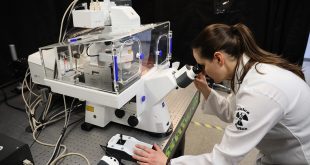A sampler of 10 Canadian genomic initiatives to watch
By Jana Manolakos
Despite a slower pace than other countries, Canada’s genomic research landscape is expanding, powering up Canada’s contributions to genetics and biotechnology in health, agriculture and the environment.
From precision health, which harnesses the potency of genome sequencing to diagnose and determine treatment of genetic conditions, to the barcoding of species, public and private sector organizations are pushing new horizons in genomics often as partners, unravelling the complexities of an organism’s genes in an effort to discover new therapies and applications.
Among these, Genome Canada, a government agency launched in 2000, spearheads a national strategy along with a network of six regional centres on the West Coast (Genome BC), the Prairies (Genome Alberta and Genome Prairie), central Canada (Ontario Genomics and Génome Québec), and the Maritimes (Genome Atlantic). Then there’s CGEn, a federally funded national platform for genome sequencing and analysis with nodes in Toronto (The Centre for Applied Genomics at The Hospital for Sick Children), Montréal (McGill Genome Centre at McGill University), and Vancouver (Canada’s Michael Smith Genome Sciences Centre).
Private sector start-ups have also staked their claim. Take Deep Genomics, which applies artificial intelligence in searching for life-saving genetic therapies; Precision Nanosystem, which is focused on gene function in neurons and glia cells; and DalCor Pharmaceuticals, which is genetically targeting patients that will benefit from precision treatments for cardiovascular disease.
Among an impressive array of genomic initiatives, here are 10 game changers working to put Canada on the map.
Canada’s largest human genome sequencing initiative
Led by CGEn, the HostSeq databank will include the full set of DNA of 10,000 Canadians, with the goal of understanding how their genetics influenced their individual responses to COVID-19. The HostSeq databank also includes linked standardized clinical information collected at multiple clinical sites across Canada over the past two years of the pandemic. “The need for a national genomics databank grew very quickly early on in the pandemic,” explains Dr. Naveed Aziz, chair of the HostSeq Implementation Committee and Chief Executive Officer, CGEn. “As soon as we started to observe differences of disease manifestation and symptoms in people infected with SARS-CoV-2 virus, we realized that there was an urgent need to collect and analyze population-wide host genetic data.” The initiative, funded through Genome Canada’s Canadian COVID-19 Genomics Network (CanCOGeN), is accessible to Canadian and international researchers.
Gene mutations may hold the key to ovarian cancer
Ovarian cancer affects about 3,000 women every year in Canada. Although most cases are sporadic, there are hereditary forms of ovarian cancer that are largely attributed to mutations in the BRCA1 and BRCA2 genes, which are also involved in breast cancer. However, some families with no known cancer-predisposing genes develop multiple cases of ovarian cancer, suggesting that mutations in unknown genes remain to be discovered.
With this in mind, scientists at the Research Institute of the McGill University Health Centre (RI-MUHC) set out to investigate new genes that could be associated with a risk of ovarian cancer. Their findings show that a mutation in a specific protein gene known as FANCI (FA Complementation Group I) is more common in ovarian cancer patients with a family history of ovarian cancer than in cancer-free people, suggesting that it may influence the risk of developing that cancer. Dr. Patricia Tonin, principal investigator of the study and senior scientist in the Cancer Research Program at the RI-MUHC, explains: “This study emphasizes the importance of pursuing variants during the gene discovery phase, especially when plausible gene candidates are revealed by analyses of defined cancer families.”
The researchers performed genetic testing on two sisters who had ovarian cancer and a family history of ovarian cancer. Next-generation sequencing showed that both subjects carried a mutation in the FANCI gene. The researchers then sequenced familial cases of ovarian cancer and compared variant frequencies in people with and without ovarian cancer in a population pool of French Canadians from Québec. This population has a unique genetic landscape inherited from common ancestors that arrived in Québec from Western Europe as early as the 1600s.
The study authors also point out that other genetic, environmental or host factors could affect the risk of ovarian cancer in carriers of FANCI variants. Replication studies are needed to confirm these results in larger groups worldwide. In addition, studies to clarify the cancer risk conferred by FANCI variants are required to inform medical genetic screening practices for managing risk and ovarian cancer.
New national platform advances clinical genomic testing
Canadians struggling to get a diagnosis will now have access to state-of-the-art genome-wide sequencing thanks to a new pan-Canadian All for One precision health partnership led by Genome Canada. Already deployed across six implementation projects serving nine provinces, the $39-million All for One initiative includes $13 million in federal investment through Genome Canada and $26 million in co-funding from industry, health-care organizations, provincial governments, and other partners brought in through six regional Genome Centres.
CanSeq150
To commemorate Canada’s sesquicentennial in 2017, CGEn and its partners embarked on the Canada 150 Sequencing Initiative (CanSeq150) aimed at sequencing 150 new genomes to support sequence-based genomics research in Canada in biodiversity and conservation, applications in breeding and biomedicine, and technology development. More than 100 species were selected for sequencing through the CanSeq150 program, providing a platform for biologists, ecologists, population geneticists and other scientists to work with genomic scientists. CanSeq150 has now joined the Canadian arm of the Earth BioGenome project (featured in the spring issue of BioLab Business), which will identify an additional 400 species important to Canadian wildlife conservation, recovery and monitoring.
Bridging the genomic divide for Indigenous children
Although the rapid development of genomic technologies is advancing precision medicine, it is also widening the health inequity gap for Indigenous populations that often have little or no access to genomic technologies and the research that drives them. This prevents accurate diagnosis because of the absence of the reference data needed for precise genetic diagnosis. Working with Genome BC, Genome Canada last year launched Silent Genomes, a partnership with First Nations, Inuit and Métis peoples to enable access to diagnosis and treatment of genetic disease for their children. The project will establish processes for Indigenous governance of biological samples and genomic data, lead to policy guidelines and best practice models for bringing genomic testing to Indigenous children, and develop an Indigenous Background Variant Library of genetic variation from a diverse group of First Nations.
New non-human genetic data bank leverages artificial intelligence
This past April, Génome Québec and Université Laval launched Genovalia, the first centre in Québec dedicated to the production, processing, and application of non-human genomic data in agri-food, forestry and environmental sciences. Bolstered by Université Laval’s artificial intelligence experts, Genovalia aims to contribute to standardization in data collection, increase information sharing, grow computational capacity and develop better analytical tools.
Keeping feeder fish and the salmon industry healthy
Sea lice, which feed on the skin of living salmons, are a big problem for Canada’s commercial Atlantic salmon industry, costing producers $18 million last year alone in lost stock. To mitigate the problem, feeder fish like lumpfish are introduced to salmon tanks to eat the tiny crustaceans. However, lumpfish are highly susceptible to Vibrio anguillarum, a bacterial pathogen which causes haemorrhagic septicaemic disease in the fish. Keeping them healthy is the focus of genomic research at Memorial University’s Ocean Science Centre (OSC) in St. John’s, Nfld., where a research team, led by Javier Santander, a marine microbiologist and Associate Professor in the Department of Ocean Sciences at Memorial, has been sequencing lumpfish and cunner genomes. Santander believes the team is close to solving the lumpfish’s high susceptibility to the pathogen. “We have an effective vaccine that has been tested several times and soon will be evaluated in the field,” he said. His research group is now processing the data for transcriptomic profiling of the lumpfish response to the effective immunization.
Four genomics and engineering biology teams win funding for cellular agriculture initiatives
Cellular agriculture encompasses several innovative approaches that use cell cultures, tissue-engineering, or precision fermentation-based techniques that push beyond conventional production. This past May, four genomics and engineering biology projects won more than $900K in funding from AcCELLerate-ON, Canada’s first regional cellular agriculture competition in support of food innovation in Ontario. Ardra Inc. was named for its development of fermentation-based production of heme, a natural flavour ingredient that mimics the taste of meat. Cell Ag Tech won for scaling up the manufacturing of fish muscle stem cells from a 2D to 3D culture system with proteomic assessments of the cells. The third recipient, Evolved, won for creating cultivated pork belly that is identical to conventional pork belly. The University of Toronto’s Dr. Michael Garton, in collaboration with MyoPalate, shared in the prize for establishing the foundational tools for cultivated pork production. The funding comes from Ontario Genomics and the Canadian Food Innovation Network.
Keeping ahead of global competitors with specialized lentils
Canada grows more than 3 million tonnes of lentils annually, more than half of the world’s total supply. Nearly all (about 95%) of Canada’s lentil crops, which produced almost $3 billion in export revenue in 2021, are grown in Saskatchewan. But global competition is heating up, so researchers working on the EVOLVES (Enhancing the Value of Lentil Variation for Ecosystem Survival) project at the University of Saskatchewan are looking at growing specialized lentils. A significant part of the project is improving the genetic variability, phenotyping and gene sequencing of both cultivated and wild lentils. EVOLVES also takes an ‘omics (combining genomics and phenomics) approach so traits that are prized by exporters like greater nutritional content, flavour and climate resistance can be zeroed in on to produce specific varieties. Field trials will begin this summer in Saskatchewan and southern Italy. The initiative is supported by Genome Prairie, Saskatchewan Pulse Growers, Western Grains Research Foundation, and Agriculture and Agri-Food Canada.
Genomic tools will help support better mite resistance
Honey bee colony collapse is a significant problem for both Canada and the world because of the insect’s vital importance to pollination and food production. Unfortunately, the mite Varroa destructor feeds on bees at adult and juvenile stages, weakening them and transmitting deadly viral infections that can lead to colony collapse. Recently, a new acaricide that is poisonous to mites like the Varroa but does not harm bees and vertebrates was introduced to the industry. A Genome BC-funded project aims to discover the efficacy of this new compound. Researchers are using proteomics tools to identify the molecular target and determine how, when and where the compound can be used. The project will run until September 2023 so that early learnings can be applied to the next cycle of field testing.
 BioLab Business Magazine Together, we reach farther into the Canadian Science community
BioLab Business Magazine Together, we reach farther into the Canadian Science community





